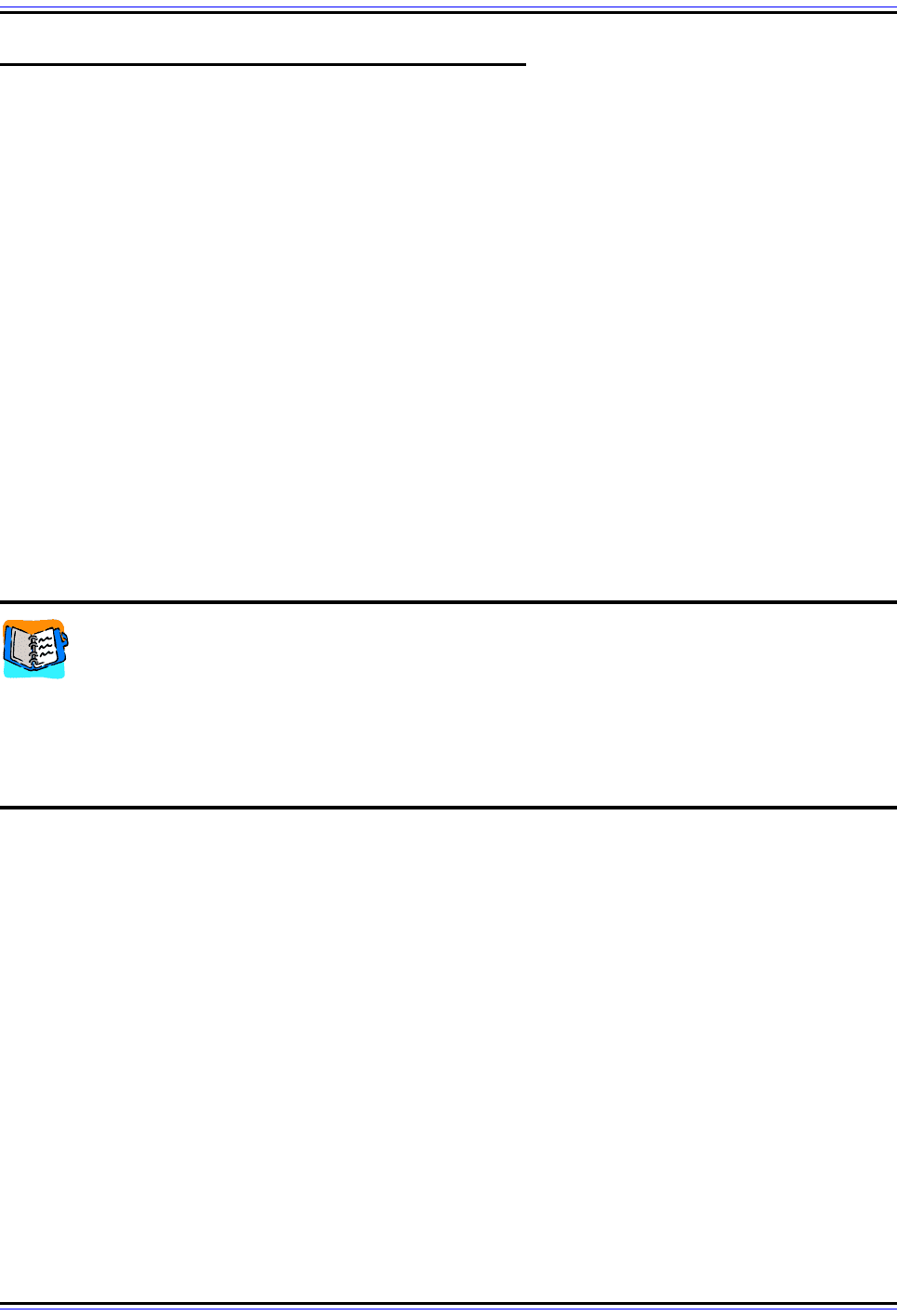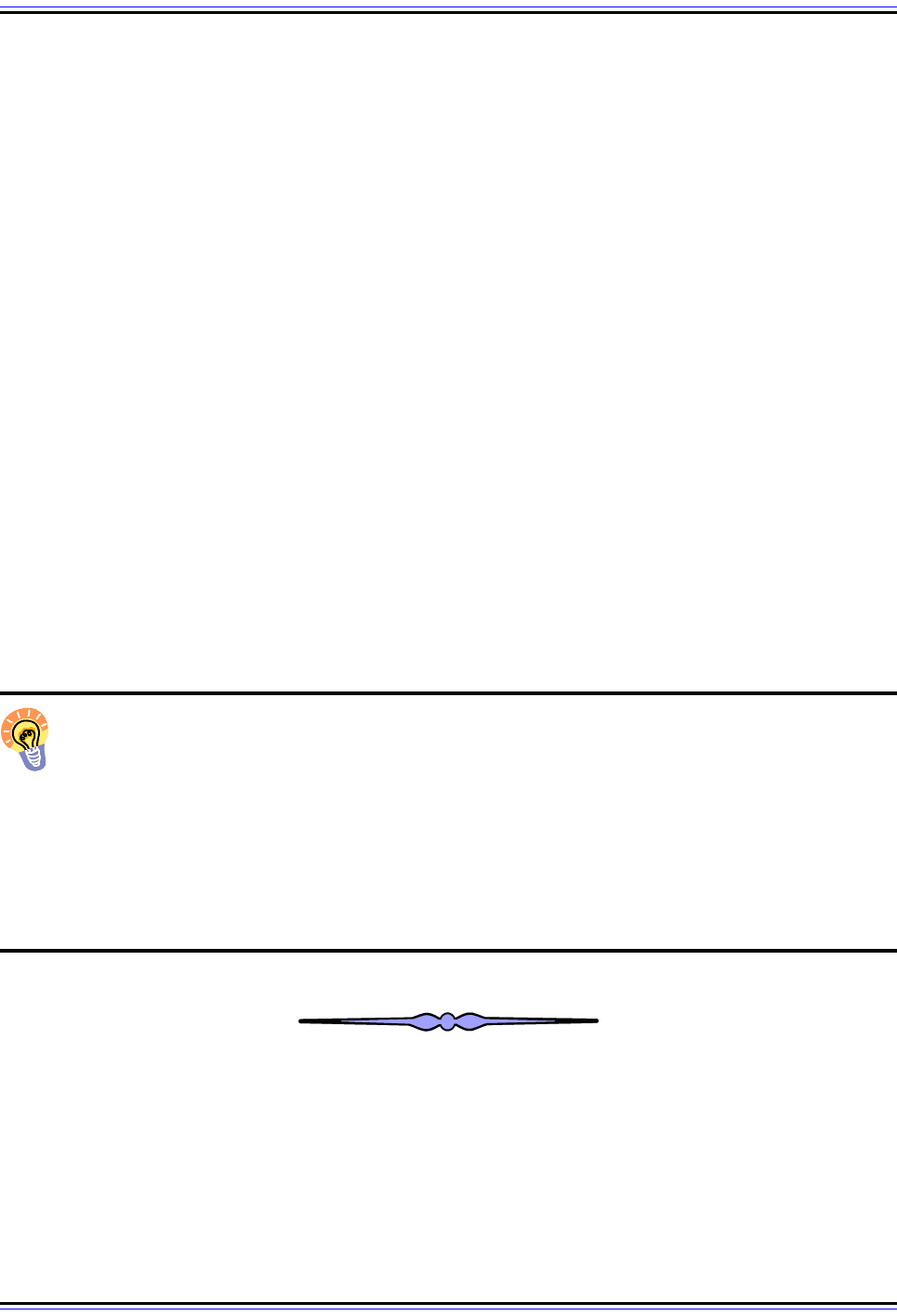Charles M. Kozierok The TCP-IP Guide
Подождите немного. Документ загружается.


The TCP/IP Guide - Version 3.0 (Contents) ` 1531 _ © 2001-2005 Charles M. Kozierok. All Rights Reserved.
Heading
<h1>First Topic</h1>
<h2>Subtopic</h2>
Defines section headings, to allow information in a
long document to be displayed in hierarchical form.
Six sets of tags are defined, from <h1> and </h1> to
<h6> and </h6>. Browsers will automatically display
the “higher-level” headings in more prominent ways,
by using larger fonts, underlining the text, or similar.
List
<p>Shopping list:
<ul>
<li>Milk
<li>Eggs
<li>Sushi
</ul>
</p>
Allows information to be presented as a list. The tag
“<ul>” means “unnumbered list” and causes the list
items to be shown usually as bullet points. Alter-
nately, “<ol>” (“ordered list”) can be used to show the
items preceded by 1, 2, 3 and so on.
Horizontal
Rule
…end of this part of the story.</p>
<hr size= “3”>
<p>Start of next part of story…
Draws a horizontal line across the page; the “size”
parameter controls its thickness. Used to separate
logical sections in a document.
Image
<img src=”companylogo.gif”
alt=”XYZ Industries Logo”
align=“center”>
Displays an inline image in the appropriate section of
the text. The “src” parameter is a relative or absolute
URL for the image, and numerous other parameters
can be included to define the image's alignment, size,
“alternate text” to display if the browser is non-
graphical (as shown here with the “alt” parameter)
and much more.
Link
<a href=“http://
www.PCGuide.com”>Click here to
visit The PC Guide</a>
Hyperlinks to another document. The “a” in the tag
stands for “anchor”, which is the formal name for a
hyperlink. the “href” parameter specifies the URL of
the link.
Most browsers will underline or otherwise highlight
the text between the start and end tags to make it
clear that the text represents a hyperlink. It is also
possible to give a hyperlink to an image by combining
the “<img>” and “<a>” tags.
Bookmark
<a name=“Step4”>Step 4: Remove
paint using scrubbing tool.</a>
Creates a bookmark that can be used to hyperlink to
a particular section in a document. For example, if the
bookmark in this example was in a document at URL
“http://www.homefixitup.com/repainting.htm”, the URL
“http://www.homefixitup.com/repainting.htm#Step4”
refers to this particular place in the document. See
the next topic on URLs for more details.
Table 274: Common Hypertext Markup Language (HTML) Elements (Page 2 of 3)
Element Example Element and Tags Description

The TCP/IP Guide - Version 3.0 (Contents) ` 1532 _ © 2001-2005 Charles M. Kozierok. All Rights Reserved.
Common Text Formatting Tags
There are also numerous tags that are used to format the appearance of text within a
document; some of the more common ones:
☯ <b>text</b>: Present the enclosed text in bold.
☯ <i>text</i>: Present the enclosed text in italics.
☯ <u>text</u>: Present the enclosed text underlined.
☯ <font (parameters)>text</font>: Present the enclosed text using the indicated font
type, size or color.
Again, this is just the tip of the iceberg when it comes to HTML. If you are not familiar with
HTML, however, knowing these basic tags should be enough to help you interpret basic
HTML documents and learn how HTTP works.
Tab le
<table>
<tr>
<td>1st row, 1st column.</td>
<td>1st row, 2nd column.</td>
</tr>
<tr>
<td>2nd row, 1st column.</td>
<td>2nd row, 2nd column.</td>
</tr>
</table>
Displays information in tabular form. Each “<tr>” and
“</tr>” tag set defines one row of the table; within
each row, each “<td>” and “</td>” pair defines one
table data element. Many different parameters can be
provided for each of these tags to control table size
and appearance.
Form
<form method="POST"
action="https://
www.myfavesite.com/order.php">
<input type="hidden"
name="PRODUCT"
value="widget">
<input type=”text”
name=”QUANTITY” size="3">
<input type="submit" value="Click
Here to Proceed to the Secure
Processing Site">
</form>
Defines an HTML form, allowing various sorts of infor-
mation to be submitted by a client to a program on a
Web site designed to process forms. The form
consists of the initial “<form>” tag that describes what
action to be taken when the submission button is
pressed, and other form items such as predefined
variables, text entry fields, and buttons; one example
of each of these items is shown here.
Script
<script language=javascript>
(Javascript code)
</script>
Allows instructions in a scripting language to be
included in an HTML document. Most often used for
Javascript.
Table 274: Common Hypertext Markup Language (HTML) Elements (Page 3 of 3)
Element Example Element and Tags Description

The TCP/IP Guide - Version 3.0 (Contents) ` 1533 _ © 2001-2005 Charles M. Kozierok. All Rights Reserved.
Key Concept: The language used by World Wide Web hypertext documents is
called the Hypertext Markup Language (HTML). HTML documents are as ASCII text
files, but are arranged using a special structure of HTML elements that define the
different parts of the document and how they should be displayed to the user. Each element
is described using special text tags that define it and its characteristics.
World Wide Web Addressing: HTTP Uniform Resource Locators (URLs)
The main reason that hypertext is so powerful and useful is that it allows related documents
to be linked together. In the case of the World Wide Web, this is done using a special set of
Hypertext Markup Language (HTML) tags that specifies in one document the name of
another document that is related in some important way. A user can move from one
document to the next using a simple mouse click. The Web has succeeded largely on the
basis of this simple and elegant method of referral.
The notion of hyperlinking has some important implications on how Web documents and
other resources are addressed. Even though the Web is at its heart a message transfer
protocol similar to the File Transfer Protocol (FTP), the need to be able to define hyperlinks
meant that the traditional FTP model of using a set of commands to specify how to retrieve
a resource had to be abandoned. Instead, a system was needed whereby a resource could
be uniquely specified using a simple, compact string.
The result of this need was the definition of one of the three primarily elements of the World
Wide Web: the Uniform Resource Identifier (URI). URIs are divided into two categories:
Uniform Resource Locators (URLs) and Uniform Resource Names (URNs). While URIs,
URLs and URNs grew out of the development of the Web, they have now been generalized
to provide an addressing mechanism for a wide assortment of TCP/IP application layer
protocols. They are thus described in detail in a separate section; this topic will provide
more information on how they are used specifically for the Web.
At the present time, the Web uses URLs almost exclusively; URNs are still in development.
Web URLs specify the use of the Hypertext Transfer Protocol (HTTP) for resource retrieval,
and are thus normally called HTTP URLs. These URLs allow a resource such as a
document, graphical image or multimedia file to be uniquely addressed by specifying the
host name, directory path and file name where it is located.
Key Concept: Uniform Resource Identifiers (URIs) were developed to allow World
Wide Web resources to be easily and consistently identified; they are also now used
for other protocols and applications. The type of URI currently used on the Web is
the Uniform Resource Locator (URL), which identifies the use of HTTP to retrieve a
resource, and provides information on where and how it can be found and retrieved.

The TCP/IP Guide - Version 3.0 (Contents) ` 1534 _ © 2001-2005 Charles M. Kozierok. All Rights Reserved.
HTTP URL Syntax
HTTP URLs may be absolute or relative. Absolute URLs are usually used for hyperlinks
from one Web site to another, or by users requesting a new document without any prior
context. Absolute HTTP URLs are based on the following common Internet URL syntax:
<scheme>://<user>:<password>@<host>:<port>/<url-path>;<params>?<query>#<fragment>
For the Web, the scheme is “http:” and the semantics of the different URL elements is
defined to have meanings that are relevant to the Web. The general structure of an HTTP
URL is thus:
http://<user>:<password>@<host>:<port>/<url-path>?<query>#<bookmark>
The following shows how these syntactic elements are specifically defined for HTTP
absolute URLs:
☯ <user> and <password>: Optional authentication information, for resources located
on password-protected servers. This construct is rarely used in practice and so most
people don't realize it is an option; it has thus become a target of abuse by con artists
who use it to obscure undesirable URLs.
☯ <host>: The host name of the Web server upon which the resource is located. This is
usually a fully-qualified DNS domain name, but may also be an IP address.
☯ <port>: The TCP port number to use for connecting to the Web server. This defaults to
80 for HTTP and is usually omitted. Rarely, you may see some other port number
used, sometimes to allow two copies of Web server software devoted to different uses
on the same IP address; port 8080 is especially common as an alternative.
☯ <url-path>: The path pointing to the specific resource to be retrieved using HTTP. This
is usually a full directory path expressing the sequence of directories to be traversed
from the root directory to the place where the resource is located, and then the
resource's name. It’s important to remember that the path is case-sensitive, even
though DNS domain names are not.
☯ <query>: An optional query or other information to be passed to the Web server. This
feature is commonly used to implement interactive functions, because the query value
can be specified by the user and then be passed from the Web browser to the Web
server. The alternative method is by using the HTTP POST method.
☯ <bookmark>: Identifies a particular location within an HTML document. This is
commonly used in very large HTML documents to allow a user to click a hyperlink and
scroll to a particular place in the document. See the example in the previous topic
(near the end of Table 274).
Although the URL syntax for the Web is quite “rich” and potentially complex, most Web
URLs are actually quite short. The vast majority of these components are omitted,
especially the user, password, port and bookmark elements; queries are also used only for
special purposes. This leaves the more simplified form you will usually encounter for URLs:
http://<host>/<url-path>

The TCP/IP Guide - Version 3.0 (Contents) ` 1535 _ © 2001-2005 Charles M. Kozierok. All Rights Reserved.
Resource Paths and Directory Listings
The <url-path> used to reference a particular document can also be omitted. This provides
a convenient way for a user to see what content is offered on a Web site without needing to
know what particular document to request. For example, a user who wants to just see what
the current headlines are on CNN would just go to “http://www.cnn.com”. In this case, the
request is sent to the Web server for the null document “/” (which is implied if it is not
specified; technically you are supposed to specify “http://www.cnn.com/”).
How such a “/” request is handled depends on the server. Technically, such a request is
actually asking the server “please show me the contents of the root directory of the server”.
However, this is both ugly (a listing of file names is not the best way to make a first
impression) and a potential security issue (as anyone can see the name of every file on the
server). Instead, most HTTP servers are set up to automatically recognize such requests
and return a default document, often named something like “index.html” or “default.html”.
Many servers will similarly return a default document of some sort if any other directory is
specified in a URL; for example, “http://www.pcguide.com/ref” actually returns “http://
www.pcguide.com/ref/index.htm”.
The forms above apply to absolute HTTP URLs. URLs may also be relative; this is the norm
for links between closely related documents, such as graphics that go with a document, or
between documents in a set or project. In this case, usually only a fractional portion of a
URL path is specified; this is described fully in the topic on relative URLs.
Note that while it is technically incorrect to leave the “http://” off an HTTP URL, most Web
browsers will add it automatically if omitted. As a result, many Web users are in the habit of
entering “URLs” that are simply a host name, such as just “www.pcguide.com”.

The TCP/IP Guide - Version 3.0 (Contents) ` 1536 _ © 2001-2005 Charles M. Kozierok. All Rights Reserved.
TCP/IP Hypertext Transfer Protocol (HTTP)
The success of the World Wide Web is a result of the efficiency and usefulness of the
complete hypermedia system it implements. We examined in the last section the basic
concepts behind hypertext, and looked at two of the three major components that comprise
the World Wide Web system: HTML and URLs. The third major component of the Web is
arguably the most important: the protocol that actually transfers hypertext documents and
other files between Web servers and Web clients (browsers). This is one of the most widely-
known software protocols in all of networking: the Hypertext Transfer Protocol (HTTP).
In this section I provide a detailed description of the Hypertext Transfer Protocol. I begin
with an overview of HTTP and a discussion of its history and versions, and the standards
that define them. I then describe the operation of the protocol in five subsections. The first
discusses HTTP's operation in general terms, focusing on how connections are established
and maintained. The second describes HTTP messages and how they are formatted, and
describes HTTP methods (commands) and status codes. The third details the many HTTP
headers, which are critically important as they are the primary way that information is
communicated between HTTP servers and clients. The fourth subsection provides infor-
mation about how resources, called entities, are encoded and transferred in HTTP. The final
subsection describes special features and capabilities of the modern HTTP protocol.
Background Information: Like so many TCP/IP protocols, when HTTP was
designed, its creators “borrowed” elements from other application protocols. In this
case, HTTP uses certain elements from e-mail, especially the Multipurpose
Internet Mail Extensions (MIME). I would recommend familiarity with both the RFC 822 e-
mail message format and MIME, especially MIME headers and media types, before reading
this section. The relationship between HTTP and MIME is covered in the topic discussing
HTTP entities and media types.

The TCP/IP Guide - Version 3.0 (Contents) ` 1537 _ © 2001-2005 Charles M. Kozierok. All Rights Reserved.
HTTP Overview, History, Versions and Standards
The World Wide Web had humble beginnings, as a research project at the Swiss research
institute, CERN. The primary goal of the project was to allow hypertext documents to be
electronically linked, so selecting a reference in one document to a second one would
cause it to be retrieved. To implement this system, some sort of mechanism was needed to
allow a client computer to tell a server to send it a document. To fill this function, the early
developers of the Web created a new TCP/IP application layer protocol: the Hypertext
Transfer Protocol (HTTP).
HTTP/0.9
The original version of HTTP was intended only for the transfer of hypertext documents,
and was designed to be very simple to make implementation of the fledgling Web easier.
This early HTTP specifies that an HTTP client establishes a connection to an HTTP server
using TCP. The client then issues a single “GET” request specifying a resource to be
retrieved. The server responds by sending the file as a stream of text bytes, and the
connection is terminated. The entire document defining this version of HTTP is only a
couple of pages long!
This first version of HTTP was functional, but extremely limited in its capabilities. It didn't
support the transfer of any types of data other than hypertext, and it provided no
mechanism for any sort of “intelligent” communication between the client and server. This
early HTTP prototype was not up to the task of providing the basis for data transfer for the
future of the World Wide Web. It was never made an official RFC standard, and in fact,
never even had a formal version number; it is known today as HTTP version 0.9, or “HTTP/
0.9” using the version format used by HTTP. I believe this number has no particular signifi-
cance other than being a bit smaller than the number of the first official version of the
protocol.
HTTP/1.0
The skeleton of functionality that HTTP/0.9 formed the basis for a rapid evolution of HTTP
in the early 1990s. As the World Wide Web grew in size and acceptance, many new ideas
and features were incorporated into HTTP. The result of a great deal of development effort
was the formalization of the first HTTP standard: version 1.0. This much enhanced HTTP
was published in May 1996 as RFC 1945, Hypertext Transfer Protocol — HTTP/1.0. It had
been in use for several years prior to that formal publication date, however.
HTTP/1.0 transformed HTTP from a trivial request/response application to a true
messaging protocol. It described a complete message format for HTTP, and explained how
it should be used for client requests and server responses. One of the most important
changes in HTTP/1.0 was the generalization of the protocol to handle many types of
different media, as opposed to strictly hypertext documents. This was done by borrowing
concepts and header constructs from the Multipurpose Internet Mail Extensions (MIME)
standard defined for e-mail. At the same time that it defined much more capable Web
servers and clients, HTTP/1.0 retained backwards compatibility with servers and clients still
using HTTP/0.9.

The TCP/IP Guide - Version 3.0 (Contents) ` 1538 _ © 2001-2005 Charles M. Kozierok. All Rights Reserved.
HTTP/1.0 was the version of HTTP that was widely implemented in the mid-1990s as the
Web exploded in popularity. After only a couple of years, HTTP accounted for the majority
of the traffic on the burgeoning Internet. The popularity of HTTP was in fact so great that it
single-handedly prompted the installation of a lot of new hardware to handle the load of
browser requests and Web server replies.
Unfortunately, much of this huge load of traffic was due to some limitations in HTTP itself.
These only became apparent due to the tremendous growth in the use of the protocol
which, combined with the normal growing pains of the Internet, led to many frustrated Web
users. The inefficiencies of HTTP version 1.0 were a result of design limitations such as the
need for each site to be hosted on a different server, the fact that each HTTP session
handled only one client request, and a general lack of support for necessary performance-
enhancing features such as caching, proxying and partial resource retrieval.
HTTP/1.1
While impatient pundits coined sarcastic terms such as the “World Wide Wait”, the IETF
continued to work to improve HTTP. In January 1997, the first draft version of HTTP/1.1
appeared: in RFC 2068. This document was later revised and published as RFC 2616,
Hypertext Transfer Protocol — HTTP/1.1, in June 1999. HTTP/1.1 retains backwards
compatibility with both HTTP/1.0 and HTTP/0.9. It is accompanied by RFC 2617, HTTP
Authentication: Basic and Digest Access Authentication, which deals with security and
authentication issues.
HTTP/1.1 introduces several significant improvements over version 1.0 of the protocol,
most of which specifically address the performance problems I just described. Some of the
more important improvements in version 1.1 are:
☯ Multiple Host Name Support: In HTTP/1.0, there was no way to specify the host
name of the server to which the client needed to connect. As a result, the Web server
at a particular IP address could only support one domain name. This was not only
inefficient, it was exacerbating the depletion of IP addresses in the 1990s, because
each new Web server to come online required a new IP address. HTTP/1.1 allows one
Web server to handle requests for dozens or even hundreds of different virtual hosts.
☯ Persistent Connections: HTTP/1.1 allows a client to send multiple requests for
related documents to a server in a single TCP session. This greatly improves perfor-
mance over HTTP/1.0, where each request required a new connection to the server.
☯ Partial Resource Selection: In HTTP/1.1, a client can ask for only part of a resource
rather than the entire document, which reduces the load on the server and saves
transfer bandwidth.
☯ Better Caching and Proxying Support: HTTP/1.1 includes many provisions to make
caching and proxying more efficient and effective than they were in HTTP/1.0. These
techniques can improve performance by providing clients with faster replies to their
requests while reducing the load on servers, as well as enhancing security and imple-
menting other functionality.
☯ Content Negotiation: A negotiation feature was added that allows the client and
server to exchange information to help select the best resource or version of a
resource when multiple variants are available.

The TCP/IP Guide - Version 3.0 (Contents) ` 1539 _ © 2001-2005 Charles M. Kozierok. All Rights Reserved.
☯ Better Security: HTTP/1.1 defines authentication methods and is generally more
“security aware” than HTTP/1.0 was.
In addition to these notable improvements, many other minor enhancements were made in
HTTP/1.1. Several of these take the form of new headers that can be included in client
requests to better control under what circumstances resources are retrieved from the
server, and headers in server responses to provide additional information to the client.
Future HTTP Versions
HTTP/1.1 continues to be the current version of the Hypertext Transfer Protocol, even
though it is now several years old. This may seem somewhat surprising, given how widely
used HTTP is. Then again, it may be the fact that so many millions of servers and clients
implement HTTP/1.1 that no new version has been created. For a while there was specu-
lation that version 1.2 of HTTP would be developed, but this has not happened.
In the late 1990s, work began on a method of expanding HTTP through extensions to the
existing version 1.1. Development of the HTTP Extension Framework proceeded for a
number of years, and in 1998 a proposed draft for a new Internet standard was created.
However, as I just said, HTTP/1.1 is so widely deployed and so important that it was very
difficult to achieve consensus on any proposal to modify it. As a result, when the HTTP
Extension Framework was finally published in February 2000 as RFC 2774, the universal
acceptance required for a new standard did not exist. The framework was given “experi-
mental” status, and never became a formal standard.
Key Concept: The engine of the World Wide Web is the application protocol that
defines how Web servers and clients exchange information: the Hypertext Transfer
Protocol (HTTP). The first version of HTTP, HTTP/0.9, was part of the early World
Wide Web and was a very simple request/response protocol with limited capabilities that
could transfer only text files. The first widely-used version was HTTP/1.0, which is a more
complete protocol that allows the transport of many types of files and resources. The
current version is HTTP/1.1, which expands HTTP/1.0’s capabilities with several features
that improve the efficiency of transfers and address many of the needs of the rapidly
growing modern World Wide Web.

The TCP/IP Guide - Version 3.0 (Contents) ` 1540 _ © 2001-2005 Charles M. Kozierok. All Rights Reserved.
HTTP General Operation and Connections
The Hypertext Transfer Protocol (HTTP) began as an extremely basic protocol, designed to
do just one thing: allow a client to send a simple request for a hypertext file and receive it
back from the server. Modern HTTP remains at its heart a straight-forward request/reply
protocol, but now includes many new features and capabilities to support the growing size
of the World Wide Web and the ever-increasing variety of ways that people have found to
use it. The best place to start in explaining HTTP is thus by looking at its operation as a
whole and how communication takes place between a Web server and a Web client.
In this section I introduce the Hypertext Transfer Protocol by describing its operation in
general terms. I begin with a high-level overview of HTTP and discussion of its operational
model. I explain the two types of connections that are supported between HTTP clients and
servers, and the method by which requests can be pipelined in HTTP/1.1. I then provide
more information about how persistent connections are established, managed and termi-
nated in the current version of HTTP.
HTTP Operational Model and Client/Server Communication
The Hypertext Transfer Protocol is the application-layer protocol that implements the World
Wide Web. While the Web itself has many different facets, HTTP is only concerned with one
basic function: the transfer of hypertext documents and other files from Web servers to Web
clients. In terms of actual communication, clients are chiefly concerned with making
requests to servers, which respond to those requests.
Thus, even though HTTP includes a lot of functionality to meet the needs of clients and
servers, when you boil it down, what see is a very simple, client/server, request/response
protocol. In this respect, HTTP more closely resembles a rudimentary protocol like BOOTP
or ARP than it does other application-layer protocols like FTP and SMTP, which all involve
multiple communication steps and command/reply sequences.
Basic HTTP Client/Server Communication
In its simplest form, the operation of HTTP involves only an HTTP client, usually a Web
browser on a client machine, and an HTTP server, more commonly known as a Web server.
After a TCP connection is created, the two steps in communication are as follows:
1. Client Request: The HTTP client sends a request message formatted according to
the rules of the HTTP standard—an HTTP Request. This message specifies the
resource that the client wishes to retrieve, or includes information to be provided to the
server.
2. Server Response: The server reads and interprets the request. It takes action
relevant to the request and creates an HTTP Response message, which it sends back
to the client. The response message indicates whether the request was successful,
and may also contain the content of the resource that the client requested, if
appropriate.
